Downloads
Introduction
Good morning, and thank you for giving me the opportunity to speak and share my thoughts on Australia's financial system as we emerge from the global financial crisis.
As a central policy agency, Treasury needs to ensure that the long-term challenges facing Australia are not sidelined by the more immediate and urgent issues.
And Australia is facing some significant challenges.
The Government's third Intergenerational Report highlighted some of the challenges in relation to demographic change and an ageing population; economic infrastructure; and climate change.
To help us meet these challenges, we need a safe and efficient financial system. A safe and efficient financial system is also important from a wellbeing perspective, given the role the financial sector plays in people's lives. The financial system:
- facilitates payments;
- supports Australians so that they can invest and save for retirement;
- enables households to save for, and purchase, housing; and
- ensures that capital is allocated efficiently, supporting investment in essential infrastructure.
We also need a safe and efficient financial system because our financial institutions play an essential role in funding our gap between domestic investment and national saving. Our institutions need the confidence of foreign investors that they will service what they borrow.
So a safe and efficient financial system is very much about the wellbeing of the Australian community as a whole.
The question policy advisers must consider continually is whether the current financial system adequately services all aspects of the community.
For Australia's financial system to be both efficient and safe, it is important that we have competition between providers of financial services, and a sound prudential regulation framework.
The global financial crisis was the most fundamental dislocation in global financial markets in our lifetimes. While the stability of banking sectors around the world has been very much the focus in the past 18 months, the crisis has also raised concerns about weakened competition in many jurisdictions. Australia's financial system has been more resilient than others but, like other countries, Australia has experienced a change in the competitive dynamics of our banking sector as a result of the crisis.
So I would like to spend some time today talking about the competitive dynamics in the banking sector, as well as the international enhancements to financial regulation that are being considered and implemented in response to the global financial crisis.
But first, I would like to reflect on the performance of the Australian financial system over the course of the global financial crisis.
The Australian Financial System
As I'm sure you are all aware, the strength of our financial system, particularly the banking sector, has been an important factor in cushioning Australia from the impact of the global financial crisis.
Australia's financial system continued to function well throughout the global financial crisis. Overall, Australia's institutions remained profitable and well-capitalised, and this allowed them to continue to lend throughout the crisis. Even so, intermediated credit from the banking sector became more expensive and subject to tighter conditions.
Some borrowers, particularly large- and medium-sized businesses, were able to raise funds from equity and debt capital markets to supplement their bank funding. Other businesses, which don't have access to these financing alternatives, have been most affected by the tightening in conditions for intermediated credit.
The strength of our banking sector reflects a number of factors, including:
- the fact that, in contrast to many of their overseas counterparts, Australian institutions entered the crisis with relatively low exposure to high-risk assets;
- the strength of the equity markets, which allowed banks to raise large amounts of equity in 2009;
- the quality of our financial regulatory system; and
- the timely action by the Reserve Bank of Australia and the Australian Government in response to the global financial crisis. In particular, the monetary and fiscal stimulus played a key role in supporting the Australian economy. The Government also introduced guarantees to support Australian institutions' access to funds.
Credit flows over of the course of the global financial crisis
At the height of the crisis in 2008, there were concerns that the extreme dislocation in financial markets would mean that Australian institutions would have to ration credit.
But this did not occur to any great extent.
Housing credit continued to grow over the course of the global financial crisis, supported by historically low interest rates, the Government's First Home Owners Boost and lenders' continued appetite for mortgage assets.
In fact, as you can see from this chart (Chart 1), total housing credit grew by 8.2 per cent over 2009.
Chart 1: Credit by sector
Year-ended percentage change
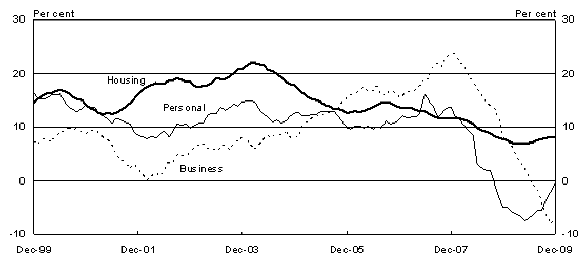
Source: RBA Financial Aggregates
Credit flows to businesses, though, have fallen. However, taking into account other sources of financing – that is, intermediated credit, equity, and non-intermediated debt such as corporate bonds – businesses' net stock of external funding increased over 2009.
As the price of intermediated credit increased, businesses elected to diversify their funding. This compares favourably with the experience of the early 1990s where the fall in intermediated credit was not fully offset by increases in non-intermediated debt and equity issuance.
Chart 2: Bank lending to large and small businesses
Year-ended percentage change
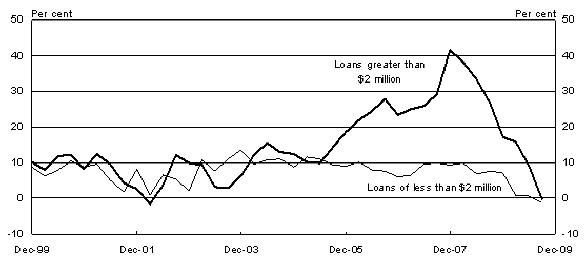
Source: RBA Statistical Tables
Small business credit has fallen, as shown in this chart (Chart 2).
Challenges in the post-global financial environment
It is fair to say that the global financial crisis itself is now behind us. While there is a risk of further adverse shocks in global financial markets, the period of extreme dislocation has now passed.
The Government's recent announcement of the removal of the Guarantee Scheme for Large Deposits and Wholesale Funding from 31 March 2010 is a further positive indication that Australia's financial system is on an upturn.
At the current time, there are two key issues at the forefront of the policy agenda for the Australian financial system. The first concerns the competitive dynamics of the banking sector. And the second concerns the implementation of international enhancements to financial regulation and supervisory practices.
Competition in Banking
Recent trends in the banking sector
Some recent trends in the banking sector have raised concerns about the competitive dynamics of the sector following the global financial crisis.
- The banking sector has become more concentrated since the onset of the crisis.
- While all of Australia's financial institutions have experienced a drop in profits as a result of the crisis, the fall has generally been more pronounced for smaller institutions.
- The major banks' net interest margins increased over the crisis.
The major banks' market share of most products increased over the course of the crisis. This chart (Chart 3) shows t
hat the share of owner-occupier housing loan approvals for the five largest banks – the majors plus St George – increased from around 60 per cent before the onset of the financial market turbulence in mid-2007 to around 82 per cent.
Chart 3: Share of owner-occupier loan approvals
By lender, seasonally adjusted
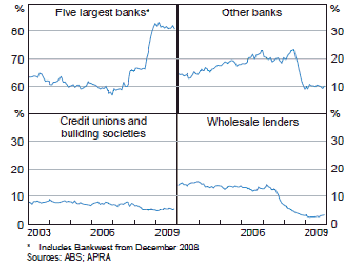
A significant driver of the consolidation of market share has been firms exiting from the market, or scaling back operations.
In particular, the closure of securitisation markets and constraints in other funding markets has forced some smaller players to exit or scale back lending.
As well, some foreign banks withdrew or scaled back their operations in Australia, reflecting adverse conditions in their home markets.
Increases in impairment levels, especially in business lending portfolios, have also forced some players to significantly scale back their operations.
The increase in market share is also partly a consequence of mergers in the banking sector. The major acquisitions over this period were, of course, the takeover of BankWest by the Commonwealth Bank of Australia and the takeover of St George by Westpac.
I would note that both of these acquisitions were cleared by the Australian Competition and Consumer Commission.
I would now like to turn to profitability.
Rates of return on equity have fallen across most categories of financial institutions. However, the fall has been greatest for the category of 'other domestic banks', which includes all of the Australian incorporated mid-tier banks.
These smaller domestic banks have experienced proportionally larger asset impairment than the majors as a result of the crisis. This partly reflects the nature of their strong regional presence which makes them more susceptible to downturns in specific regions. Smaller banks have also experienced a tightening of interest margins relative to the major banks.
Net interest margins represent the difference between the rate of interest banks and other intermediaries charge borrowers and the rate of interest they pay on their deposits and other types of funding. Where competition is increasing, it can be expected that net interest margins will fall, all else being equal.
In Australia, one of the clearest, long-term economy-wide benefits of the deregulation of the financial system has been sustained downward pressure on net interest margins (Chart 4). These have halved since 1995; in part, due to competition from non-prudentially regulated lenders and new bank entrants.
Chart 4: Major banks' net interest margins*
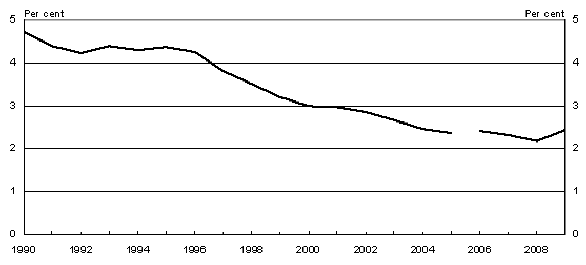
Source: RBA
* Annual net interest income as a per cent of average interest-earning assets, Australian operations. Includes St George from 1993 and Bankwest in 2009. From 2006 data are on an International Financial Reporting Standards basis; prior years are on an Australian Generally Accepted Accounting Principles basis.
By the end of 2009, the major banks' net interest margins had increased to be about 20-25 basis points higher than pre-crisis.
Impact of recent trends on the competitive dynamics of the sector
While it is difficult to be definitive, especially because interest rate margins will be affected by changes in perceptions of risk, the evidence suggests some diminution of competitive pressures over the past couple of years. Any weakening in competitive pressures would naturally be of concern to policymakers as well as customers.
However, notwithstanding the funding difficulties faced by some participants, there is evidence of some continued competitive pressures on interest rates, especially for mortgages. For example, a significant number of smaller lenders, including mutual credit unions and building societies, are offering standard variable mortgages at rates of up to one per cent less than the majors.
And as global financial markets continue to recover, we expect to see competitive pressures in the banking sector rebuild.
In particular, smaller institutions can be expected to be in a position to increase their competitive influence over time as securitisation markets recover, supported by the Government's direct investment in residential mortgage backed securites.
Further, some smaller domestic institutions that have been forced to scale back lending can be expected to become stronger competitive forces as their balance sheets recover.
Foreign banks will also be able to re-establish their presence in Australia as conditions in their home markets stabilise, although this could be a protracted process, depending on the pace of the global recovery.
It is these smaller players that have generated the most significant competitive pressure in Australia's banking sector. They have helped significantly in creating a strong competitive dynamic.
So that consumers might have access to a highly innovative and dynamic banking sector and pay lowest possible prices for banking products, it is important that we see a return of this competitive dynamic.
We are seeing some early signs of this occurring. Some of the smaller financial institutions have recommenced mortgage lending. You may have also noticed that, as part of recent profit announcements, some smaller players are now looking to actively expand their presence.
We in the Treasury will continue to monitor this recovery closely. As financial markets continue to recover, the benefits should be passed on to customers.
Having said that, we do not expect a return to the conditions that existed immediately before the crisis.
The abundance of liquidity and exuberance in global financial markets clearly meant that the price of risk was unsustainable and did not adequately reflect inherent credit risks.
With global risk expected to be priced more sustainably in future, these conditions are unlikely to return. Lenders with business models that rely on very low cost credit are likely to experience significant ongoing pressure.
The Government has taken steps to support competition.
For example, the Government's investment in residential mortgage-backed securities is supporting competition from smaller lenders at a time when securitisation markets remain affected from the fallout of the global financial crisis. This initiative continues to play an important role in promoting the market's recovery and investor confidence.
The cessation of guarantee schemes worldwide will also facilitate the return of more normal competitive market dynamics.
Economies of scale in banking
A sustained recovery in financial markets means that the smaller institutions will be in a position to increase their market share.
However, the significant economies of scale that exist for a range of banking operations mean that, in the longer term, we are likely to see continued consolidation in the sector.
One example of these economies is that in raising funds in wholesale funding markets, larger institutions are able to issue significantly larger volumes at better prices.
There are also economies of scale in risk-pooling, distribution and branch networks, staff training, computer systems, and advertising.
Economies of scale can benefit consumers by lowering the average cost of bank products. But it is important that consolidation does not lead to lessened competition. There are important safeguards under legislation, implemented by the Treasurer and Australian Competition and Consumer Commission, to prevent this from occurring.
M
arket contestability
Measures of market concentration are not enough, in themselves, to assess fully the level of competition in a given market.
It is well recognised that competition can exist even in markets with a small number of major suppliers, particularly where there are a number of smaller players or where barriers to entry are low enough for new entrants to pose a credible threat of competition.
Such markets are said to be 'contestable'.
Notwithstanding some recent increase in concentration, Australians continue to be served by a wide range of financial service providers.
The Australian banking market is currently serviced by 54 banks, 108 credit unions, 11 building societies and a number of non-deposit-taking lenders. There are currently around 110 providers of over 2,070 mortgage products.
According to the OECD1, 'even though concentration in housing loans has recently increased, the market is still contestable as non-Australian banks account for 30 per cent of business credit'.
Moreover, Australia's experience since the 1990s suggests that smaller players can compete successfully with the major banks provided they have the opportunity to raise funds at competitive prices and/or provide products and services not already provided by the majors.
Waves of consolidation in the banking sector have occurred in the past. This chart (Chart 5) shows that increases in the major banks' market share have been followed by noticeable declines during the 1980s, 1990s and 2000s.
Chart 5: Major banks' share of total resident authorised deposit-taking institution assets*
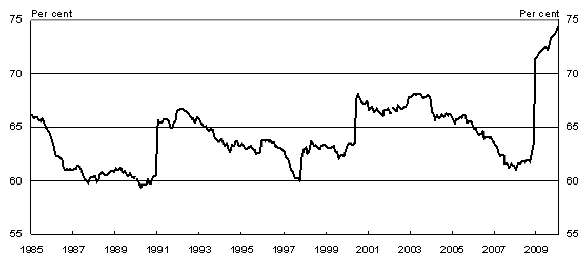
Source: RBA, APRA
* Includes BankWest and St George from December 2008. Series break in January 1990 and March 2002 due to change in reporting requirements, and data prior to January 1990 also include non-resident assets.
This is one indicator that our market is contestable even with a small number of large players.
International Financial Regulation Enhancements
As Australia emerges from the global financial crisis, there is a second area that poses challenges. This is the implementation of international financial regulation changes -- a high priority for the G20.
The global financial crisis demonstrated severe weaknesses in financial regulation in some markets. In particular, it exposed insufficient capital, too little attention to liquidity and adverse incentives for the executives of some institutions that encouraged inappropriate risk-taking. It also highlighted weaknesses in accounting standards.
The G20, the Basel Committee on Banking Supervision, the Financial Stability Board and the International Monetary Fund are the key international bodies that are developing rules and regulations designed to create a more robustly regulated global financial system.
The Basel Committee on Banking Supervision released proposals for consultation in December 2009. These focused on tightening up institutions' capital and liquid asset holding requirements.
These proposals require institutions to hold higher quality capital predominately in the form of ordinary equity, which is genuinely loss absorbing. There would also be limits on the amount of hybrid capital that institutions can hold to meet their capital requirements.
Other proposals involve the introduction of counter-cyclical capital buffers and a supplementary leverage ratio.
Strengthened liquidity rules would require institutions to hold more and higher-quality liquid assets to survive a longer period of severe market stress. These measures would make banking systems more stable and less exposed to external shocks.
The international regulatory bodies are carefully considering the exact design and detail of these proposals.
The Australian Government and regulators are active in international fora, pushing to ensure that the new rules take into account domestic circumstances across G20 economies, including Australia.
International bodies are taking time to ensure that the new rules achieve the right balance between financial system stability and the costs associated with greater regulation.
In particular, a quantitative impact assessment study is being undertaken in regard to the proposals to strengthen capital and liquidity standards in order to calibrate the new regulatory standards.
Details of the new international capital and liquidity standards are expected to be finalised by the end of 2010, with implementation phased in from 2011. There will also be transition periods after that to minimise unintended consequences.
The Australian financial system demonstrated extraordinary resilience over the course of the crisis. However, it would not be fair to say that Australia was unaffected. We should not pretend either that Australian institutions -- while highly-rated and well-capitalised -- are invulnerable to every conceivable adverse international market development.
The credit crunch exposed the fact that both the amount of liquid assets and the types of liquid assets held by financial institutions were insufficient.
Hence, while we have demonstrated strength during the global financial crisis, there are still areas where regulation could be improved.
Further, if Australia fails to implement regulations consistent with those implemented internationally, there could be a risk of Australian institutions being viewed as comparatively more risky by wholesale investors.
That said, Australian regulators need to exercise discretion to ensure that regulation is appropriately tailored to take account of Australia's circumstances while remaining consistent with internationally agreed reforms. It is important that we get the balance right between enhanced financial system stability and the costs that would be associated with greater regulation.
Conclusion
Australia's banking sector is in a sound position to continue to support growth in the economy and to meet the challenges Australia will face over the coming decades.
As the economy and financial markets recover, we want to see competitive pressures in the sector increasing.
Given the financial system's key role in the economy, we cannot be complacent. It is important that we continue to monitor the competitive dynamics of the banking sector closely and continue to empower consumers.
In addition, the global financial crisis has given us the opportunity to strengthen our financial regulation further to safeguard against future financial crises, whilst also making sure that regulation is appropriate.
Our priority is to ensure that the sector is well positioned to harness future opportunities, offer a wide range of competitively-priced products to consumers, as well as to withstand any future shocks.
Thank you.
1 OECD Reviews of Regulatory Reform, Australia 2010: Towards a seamless national economy.